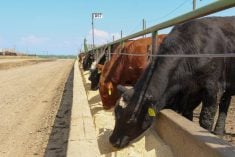During the first quarter of 2025, the U.S. and Canadian economies were vulnerable to contraction and recessionary pressures.
Major hamburger chains such as McDonald’s and Wendy’s reported lower sales from January through March, and their forward guidance expressed concerns over weaker consumer spending. Since April, government data on food spending and industry information on restaurant traffic has been contrary to the financial results and concerns of major restaurants chains.
U.S. first-quarter GDP (gross domestic product) growth came in at -0.2 per cent, quarter-over-quarter annual rate. However, U.S. second-quarter GDP growth is expected to finish around 2.3 per cent due to a rebound in consumer spending.
Read Also

Managing through market or individual stock declines
Even the best of public-traded companies can periodically experience significant drawdowns, and a successful investor should be prepared to react — or not react — accordingly, Herman VanGenderen writes.
U.S. restaurant spending during February 2025 was unchanged from February 2024. However, restaurant sales during March were up 6.7 per cent from 12 months earlier. April data showed a year-over-year increase of 6.9 per cent, and it appears May sales could be up as much as seven per cent.
Canadian sales have followed a similar pattern. Industry data shows that U.S. restaurant traffic during the last week of May was up 10 per cent from May 2024. Canadian visits to restaurants were up a whopping 24 per cent from year-ago levels. McDonald’s stock has rebounded and is only $13 from the historical high.

Wholesale beef prices and live cattle values have been trading at historical highs during the second half of May due to stronger demand. On May 28, Alberta packers were buying fed cattle on a dressed basis at $502 per hundredweight delivered. Using a 60 per cent grading, this equates to a live price of $300. This compares to a dressed value of $486/cwt. and a live price of $292/cwt. at the end of April. In Kansas and Texas, live prices f.o.b. feedlot were quoted at US$222-223/cwt., up US$10-12 per cwt. from 30 days earlier.
Market-ready fed cattle supplies are similar to year-ago levels. In the U.S., cattle on feed 150 days or longer as of May 1 were 3.188 million head, up 111,000 head from May 1, 2024. U.S. dressed weights are running 21 lbs. above year-ago levels, but it doesn’t appear that cattle are backed up in feedlots.
Shipping weights down from 2024
In Alberta and Saskatchewan, cattle on feed 150 days or longer as of May 1 were 380,376 head, down only 6.7 per cent or 27,2023 head from May 1, 2024. Earlier this spring, western Canadian dressed weights were sharply below year-ago levels, but we now find the mean weight running 15 to 20 lbs. above 2024.
The Alberta live price during the last week of May was $300/cwt. Feedlot break-even pen closeout values are around $265/cwt. Feedlot margins have been in the range of $300-500 per head. Given the healthy margin structure, feeder cattle prices have also reached historical highs. During the last week of May, larger-framed Charolais-cross steers weighing 900 lbs. were trading in the range of $415-420/cwt. Good-quality weaned steer calves averaging 500 lbs. were selling at $610-625/cwt.
I’ve received many calls asking “Where does the market go from here? Will feeder cattle prices hold up during the fall?” At the time of writing this article on June 4, 950-lb. heifers off grass for August delivery were trading in the range of $365-380/cwt. while steers were quoted from $380 to $395/cwt. The problem is, these cattle do not pencil profitably given the December live cattle futures.
A 950-lb. steer at $390/cwt. in August needs an Alberta finished price of $317/cwt. to break even. The December live cattle futures are reflecting an Alberta price of only $287. The December live cattle futures need to rally nearly US$16 from current levels so these cattle break even.
The feeder market has two functions. Firstly, the market needs to encourage expansion. Industry estimates suggest U.S. cow-calf producers will retain about 600,000 heifers for herd replacement in 2025. In Canada, we’re expecting cattle producers to hold back 60,000-70,000 heifers this year. This is causing the heifer discount to steers to narrow.
Secondly, the feeder market needs to ration demand. Prices have to move high enough so that feedlot margins move into negative territory. Alberta and U.S. feedlot margins are expected to remain in positive territory until August or September. In the latter part of summer, feedlot margins will drift into negative territory. It usually takes about one full round of feeding before the feeder market experiences a serious correction.
Canadian and U.S. beef demand reaches seasonal highs during May and June. Beef consumption tends to stagnate during July before declining in August. In the U.S., students go back to school in August, and the beef market experiences seasonal low demand during September and October.
The fed cattle market is likely near or at the top. Lower fed cattle prices are expected during the fall period as per the live cattle futures. The feeder market is in a similar situation, although the top of the market will likely occur in late July or the first half of August.
During the spring of 2026, feeder cattle prices will likely be down $40-50/cwt. compared to May 2025, which would still be decent value from a historical perspective.
















